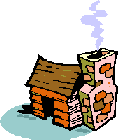Where History Lives
BURTON VILLAGE, OHIO U.S.A.
WHERE HISTORY LIVES
Back to Home Page
 When I was a reporter for the
News Herald, I researched and wrote about much of Burton's intriguing history.
On this page, you will find a synopsis of that info, including Century Village,
haunted houses, trivia tidbits, the world's only municipal sugar camp, and much
more.
When I was a reporter for the
News Herald, I researched and wrote about much of Burton's intriguing history.
On this page, you will find a synopsis of that info, including Century Village,
haunted houses, trivia tidbits, the world's only municipal sugar camp, and much
more.
Are you looking for a unique place to visit?
We have an antique/coffee shop, loads of specialty stores, a
flower shop like you have never seen, an old-fashioned hardware
store, artistic undertakings and even a gun shop. And, if you
want to stay longer than a day, we even have a Bed and Breakfast.
 And be sure to
worship with us at Burton Congregational Church on Sundays. It's
a beautiful old church with a wonderful minister and a great
group of people to worship with. Stay afterwards and join us for
coffee and refreshments in the fellowship hall. We would love to
meet you.
And be sure to
worship with us at Burton Congregational Church on Sundays. It's
a beautiful old church with a wonderful minister and a great
group of people to worship with. Stay afterwards and join us for
coffee and refreshments in the fellowship hall. We would love to
meet you.
CONTENTS
Burton's Square
Burton
Congregational Church
Ye Old Homestead Inn/Burton Fox Inn
The Opera House/Fire Station
Umberfield Tavern/Belle's Restaurant
Century Village
BURTON'S SQUARE

The first thing you might notice, especially if you visit in
the early spring, is the log cabin on the Village square. It was
built in 1931 with the cooperation of the Burton Chamber of
Commerce. It still operates today and is the only municipal sugar
camp in the world. Every year in March thousands of people come
from around the State to sample the homemade syrup served with
pancakes and sausage.
In March pancakes are served at the Burton Fire Station,
Berkshire High School, The Burton Fox Inn, Joels, and Century
Village. In the end of February and beginning of April, pancakes
are served at the American Legion Post.
Also on the square, you will notice the water tower which sits
at the north end. It was built in 1926 at a cost of $13,000. It
is 102 ft. high and used for storage purposes only. It replaced a
wooden tower which was built in 1909 for $448.
A cannon on the square has been used officially and
unofficially. It was unofficially fired by two local young men in
1909.
At that time a trolley that ran from Burton to East Ninth
Street in Cleveland. The men were returning around midnight and
having just left the big city, were struck by the quietness of
their home town.
They went to a nearby quarry, borrowed some blasting powder,
caps and a long length of fuse. When the night watchman (yes, we
actually had a night watchman) was lured to another part of the
Village, they assembled all the necessary firing equipment,
packed it all in, rammed it down with a baseball bat and lighted
the fuse.
They jumped on their horses and were half way home to south
Burton before the sound of cannon fire shattered the quiet,
peaceful night.
 YE OLDE HOMESTEAD INN/BURTON FOX INN
YE OLDE HOMESTEAD INN/BURTON FOX INN
Ye Olde Homestead Inn/Burton Fox Inn on the southwest corner
of the square was at one time a thriving restaurant and boarding
house. In it's day, it served as a rooming house, restaurant,
post office and dry goods store.
The legend began in 1832 when James and Julia Peffers bought 5
acres on the southwest corner of the square from Eleazer Hickox
for $83.00. The homestead was built on part of an 8 acre plot
valued in 1828 at $115.
It belonged to the Peffers, who had a daughter, Lucy. Lucy
married William Russell and the next six generations of Russell
family retained ownership of the building.
It was Berkshire High School's retired history teacher,
Charlie Caputo who in the fall of 1960 came from the city to live
in the country, moved into one of the rooms. He looked out his
window one evening and thought, "These country people really
know how to build a bonfire." What he didn't know is that he
was witnessing the original sugar camp on the square burning to
the ground.
He also remembers the "things that go bump in the
night," at the Inn. "It's supposed to be haunted by a
little boy named, Charlie, who must have died in the house.
Millie Russell told me that the house was haunted , a gentle
haunt, a good haunt, not an evil spirit. They heard a lot of
sounds and things that they couldn't account for." Caputo
did find a grave marker of some sort in the yard with a little
boy on it
. 
In 1974 the Russell family sold the old estate to Bill and
Joanne George who used it as a rental property for a short time
and remodeled it into a restaurant. It has had two owners since
that time.
Joanne remembered renters who complained about the noises.
"One woman renter complained about noises, but could never
find anything. There is also a story that Mrs. Russell had a
boarder who didn't use the bank and hid his money there."
Currently, it belongs to Charles Imars. The upper level is
used as a bar/restaurant five nights a week. The downstairs
doubles as an ice cream shop and antique shop.
 THE OPERA HOUSE/FIRE STATION
THE OPERA HOUSE/FIRE STATION
The Opera House or Town Hall located on the northwest corner
of the square was built in 1881 for $6,500.
Singing schools, drama club meetings, high school graduations,
town caucuses, political meetings, rallies, voting and theatrical
entertainment ranging from operas to one-act plays were all held
in this building.
In later years, silent movies were shown there. Dee White
remembers that there was a woman in the building who would play
the piano. She was four years old at the time and remembers that
stopped and then started showing the movies again when she was a
senior in high school. She most remembers the movie, Dracula.
In 1926 the Burton Volunteer Fire Department was organized. It
was in the basement of the building and the trucks were driven up
on concrete ramps. The jail was also housed in this building.
In 1953 the State building inspectors condemned the building
for public gatherings. A bond issue was passed and extensive
remodeling was done and the building was used for the trustees
and the fire department.
In the 1980's, thanks to a generous inheritance left to the
fire department by its first chief, Ray Linton, the department
was able to purchase the building. The last expansion was
completed in 1990 when two bays were added to the back of the
building. Now, in the year 2003, the Fire Department has outgrown
the building and is tossing around the idea of building a new
fire station elsewhere. The current building would be a perfect
building for the Burton Village offices.
 UMBERFIELD TAVERN/BELLE'S COLONIAL RESTAURANT Belle's
Colonial Restaurant is Burton's real-life version of
"Cheers." No one who walks through the door more than
twice is a stranger for very long.
UMBERFIELD TAVERN/BELLE'S COLONIAL RESTAURANT Belle's
Colonial Restaurant is Burton's real-life version of
"Cheers." No one who walks through the door more than
twice is a stranger for very long.
It's rich tradition dates back to 1798 when Umberfield Tavern
was located on the same site at Belles. Ironically, it was the
gathering place for local residents. The tavern burned down in
1843 allegedly by someone who had a grudge against a man who kept
his carriage in the barn.
Two years later, the Exchange Hotel took it's place. It was a
stage coach stop where the mail coaches exchanged horses. It was
subsequently used as a boarding house for students attending
Burton Academy and a hotel again.
The hotel was condemned in 1942 and torn down. In the mid-40's
Ellen B. Hosmer opened a small restaurant which was later bought
by Lillie Belle Kennedy and became "Belles Colonial
Restaurant."
Joan Pulling, who along with her husband, George, has operated
it since 1974, said at least one person wonders if some of those
people from Umberfield's are not still there. Her brother, Ken,
lived upstairs for a time and told Joan that it sounded like
there were people walking around in the restaurant during the
night. The restaurant has had many owners since that time - they
have come and gone, succeeded and failed. However, last heard,
the Pullings have regained or retained ownership of the
restaurant and it seems to be doing a thriving restaurant once
again.
 CENTURY VILLAGE
CENTURY VILLAGE
Century Village located in the center of Burton is a myriad of
historical information. It all began in 1798 when the Umberfield
family came to Burton from Connecticut.
One of their children, Stella, married Eleazer Hiscox and in
1838 they built the home that now serves as the main museum on
the grounds of Century Village.
Stella was a very resourceful woman. In those days there were
no nursing homes to put one's parents into when they were in ill
health. They either stayed alone or moved in with their children.
Stella's mother died and her father became blind and had many
other problems.
She wanted her father to move into her home with her family,
but he refused to leave his log cabin. She and Eleazer solved the
problem when they dismantled his house and in 1849 moved the
entire house to the Hiscox house and attached it to the side
porch.
If you take a tour of the village, beginning in the Hiscox
house, the tour guide will, not only tell you about the houses,
but some interesting original tidbits.
GOOD NIGHT, SLEEP TIGHT
Ever wonder about that phrase? In those days, they had rope
beds. At night they would pull the rope through the bed frame and
when they lay down, the rope would stretch and they would sink
further and further into the bed until it wobbled.
So, they pulled the rope through the holes in the frame until
they got to the end where there was a knot. They took the rope
key, put the key around the knot and turned the key so that the
bed would tighten up. The knot was retied and - Good night, sleep
tight.
I'M GOING TO HIT THE HAY
Mattresses were made from leaves or when the crop came in,
they used straw, which was pokey and sticky. At night they pushed
the hay around to make it comfortably fit their
bodies..."I'm going to hit the hay."
Ever notice how short their beds are? People propped up
pillows and reclined in beds, they didn't lay flat on their
stomachs. Benjamin Franklin said it was very important that you
don't lay down because that gave you consumption and all sorts of
strange diseases.
The baking ovens in those days were cubby holes in the
fireplace. They didn't have accurate time pieces or even a clock.
The ladies would put their bread, pies or whatever they were
making into the little oven, shut the doors and sing hymns. Old
hymnals often had the word "Time" at the end of a song
or verse. The women knew that three verses of "I Was Sinking
Deep in Sin" for instance, and two verses of whatever was
time enough and the bakery was done. Needless to say, there was a
lot of hymn singing going on during baking times.
Old barns did not have silos then. They hollowed out tree
trunks to store their grain and corn.
The term used for the station wagon automobile also came from
the three seat wagon that went to the train station to pick
people up.
POP GOES THE WEASEL
If you visit the Cook house on the museum grounds you can see
a yarn weasel. After forty turns of the weasel, a skein of yarn
is wound. You know the skein is complete because the gears make a
popping sound..."Pop goes the weasel."
In addition to the museum and all the things inside, all the
buildings on the ground have been moved from other locations
around the county.
THE HITCHCOCK HOUSE
Yale graduate, Peter Hitchcock, was Speaker to the Ohio Senate
in 1814. In 1817 he was a congressman in Washington and was
appointed to the Ohio Supreme Court in 1819. He held that
position until 1852.
His house which was built in 1813 was moved to the grounds in
1971. It was previously located at the Kent State University
extension north of town. Hiram college was involved in the
restoration of this house.
COOK HOUSE
The Cook House was one of the first frame houses in Geauga
County built in 1806 by Merriman Cook, who was related to the
Cooks who came to this country on the Mayflower.
Among the many antiques you will find in this house is the
comb back rocking chair or perhaps the first hair dryer. Of
course, the ladies of the time did not cut their hair. When they
washed it, they would sit down and flip their hair over the back
of the comb-shaped portion of the chair and rock - either outside
or in front of the fireplace. The rocking motion would gently fan
their hair and it would dry, keeping the wetness off them.
Take careful notice of the portraits in the house. Many times
an itinerant portrait painter would come around and paint the
pictures of the people in the family. Often the bodies were
already painted and the "artist" just added the head.
LAW HOUSE
The William Law house was built in 1817. William married Mrs.
Umberfield's sister. He was among the first settlers in Geauga
County and purchased his 5,600 acres for $0.62 per acre.
This house was a gift to the museum from the Sun Oil Company.
It was moved on March 2, 1961, when Sun Oil wanted to demolish it
and build a gas station on the south west corner of the square.
Not only did they donate the house, they contributed $2,850 to
move it to the Village grounds.
These people were the first recyclers. Their sinks were made
out of soapstone from the river bed. When they replaced these
sinks, they took them outside, tipped them over and used them for
steps. You will see one at the back door of this house.
They padded their rugs with straw. When it was cleaning time,
they took the rugs apart, swept out the straw and loose dirt,
filled the cracks with sand, respread the straw, and sewed the
rugs back together. And you ladies think we have it hard today.
BOUGHTON HOUSE
The Boughton house was built in 1834 and was moved to the
village in 1955. It was restored and opened to the public in
1959.
The Boughtons were very wealthy people. Their home had a
servants entrance and quarters, which was basically a hallway
next to the main bedroom. This is one of the few houses in which
you will find closets. Closets were taxed in those days.
Perhaps the most noticeable sign of wealth was the cast iron
bake oven door. Fire was the second leading cause of death among
women, childbirth being the first.
They wore long skirts and would work with open fires - not a
good combination. Fires were common place. The cheaper wooden
bake doors as well as other things would frequently cause fires
with disastrous results.
 There are
many other interesting homes, barns, mills and stores in Century
Village. This page is getting to long to continue telling you
about them. For further information contact The Geauga County
Historical society at (440) 834-4012. Century Village is located
at 14641 East Park Street, Burton, OH 44021.
There are
many other interesting homes, barns, mills and stores in Century
Village. This page is getting to long to continue telling you
about them. For further information contact The Geauga County
Historical society at (440) 834-4012. Century Village is located
at 14641 East Park Street, Burton, OH 44021.
For a Current Schedule of Events at
Century
Village
The following are some of the events scheduled yearly at
Century Village
Antique Show
Dealers with fine antiques visit Century Village for a quality
show in an historic setting. 9:30 a.m. through 5:00 p.m.
Car Show, Ice Cream Social
Restored vintage cars and our ice cream social combined for a
family outing.
Antique Power Exhibition
Old engines whistle, puff smoke, saw wood, thresh grain and
demonstrate the power that made the horse obsolete.
Apple Butter Festival - October
This is probably the Village's most popular event bringing
people from all over. The smell of apple butter permeates the
air. A celebration of fall for over 50 years. Apple butter
simmering in copper kettles, gifts, crafts, antiques and autumn
in Century Village. Test your skill by stirring the apple butter
with the large old wooden paddles.
Haunted Century Village - October
Guided tour of classic horror for the entire family.
There is an admission fee for events.
 Return to Home Page
Return to Home Page
 When I was a reporter for the
News Herald, I researched and wrote about much of Burton's intriguing history.
On this page, you will find a synopsis of that info, including Century Village,
haunted houses, trivia tidbits, the world's only municipal sugar camp, and much
more.
When I was a reporter for the
News Herald, I researched and wrote about much of Burton's intriguing history.
On this page, you will find a synopsis of that info, including Century Village,
haunted houses, trivia tidbits, the world's only municipal sugar camp, and much
more.  And be sure to
worship with us at Burton Congregational Church on Sundays. It's
a beautiful old church with a wonderful minister and a great
group of people to worship with. Stay afterwards and join us for
coffee and refreshments in the fellowship hall. We would love to
meet you.
And be sure to
worship with us at Burton Congregational Church on Sundays. It's
a beautiful old church with a wonderful minister and a great
group of people to worship with. Stay afterwards and join us for
coffee and refreshments in the fellowship hall. We would love to
meet you.
 THE OPERA HOUSE/FIRE STATION
THE OPERA HOUSE/FIRE STATION 
 There are
many other interesting homes, barns, mills and stores in Century
Village. This page is getting to long to continue telling you
about them. For further information contact The Geauga County
Historical society at (440) 834-4012. Century Village is located
at 14641 East Park Street, Burton, OH 44021.
There are
many other interesting homes, barns, mills and stores in Century
Village. This page is getting to long to continue telling you
about them. For further information contact The Geauga County
Historical society at (440) 834-4012. Century Village is located
at 14641 East Park Street, Burton, OH 44021.